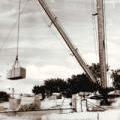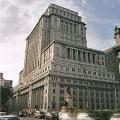 While workers elsewhere were suffering the work shortages and poverty of the worst part of the Great Depression, the "Three Villages" in the early 1930s were enjoying full employment. Sun Life, the largest office building in the British Empire, was going up, and it was being built from top to bottom of granite quarried and worked in and around Beebe, Quebec.
While workers elsewhere were suffering the work shortages and poverty of the worst part of the Great Depression, the "Three Villages" in the early 1930s were enjoying full employment. Sun Life, the largest office building in the British Empire, was going up, and it was being built from top to bottom of granite quarried and worked in and around Beebe, Quebec.
Three quarters of a century after the completion of Sun Life, that monumental edifice still holds an almost mythical status in the Beebe / Stanstead area. People, whose fathers or grandfathers cut granite for the building, still speak of Sun Life with pride.
Sun Life was actually built in several stages. The first stage began in 1914. The lower section of the office tower was inaugurated in 1918. The main section was constructed between 1927 and 1933. When complete, Sun Life’s 26 storeys and 400 feet (122 metres) would accommodate 3,000 employees.
 Construction required an astonishing 60,000 pieces of granite, including two blocks weighing 17 tons each, and 900 blocks weighing over five tons each! Sun Life was so massive that it occupied one entire side of Dorchester Square in downtown Montreal. When it opened, it breathed life into Montreal’s business district, which was beginning to shift from Old Montreal to the new city.
Construction required an astonishing 60,000 pieces of granite, including two blocks weighing 17 tons each, and 900 blocks weighing over five tons each! Sun Life was so massive that it occupied one entire side of Dorchester Square in downtown Montreal. When it opened, it breathed life into Montreal’s business district, which was beginning to shift from Old Montreal to the new city.
Built in a layered, almost pyramidical shape, and fronted with an imposing row of four-storey-high Corinthian columns, the building conveys a strong impression. Even today, all who look upon it are struck by the strength, solidity, even confidence it conveys – and what appropriate impressions for what was after all the head office of one of the world’s largest insurance companies!
Legend has it that Sun Life was so secure that during World War II, the British government stashed its gold reserves and even the crown jewels in specially-built, heavily guarded vaults in the building’s third basement. As the story goes, Winston Churchill was so worried about his country’s treasures falling into German hands in an invasion that he had them transported to Canada by boat, in containers labelled “fish.”
Telephone calls to Sun Life could confirm only that the British did store five billion dollars worth of paper securities, shipped across the ocean in absolute secrecy in 1940 – and that the subterranean vaults at Sun Life were guarded around the clock by a 24-man RCMP detachment.